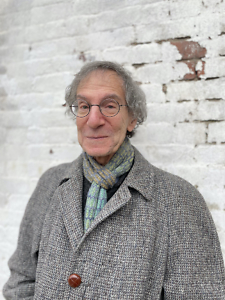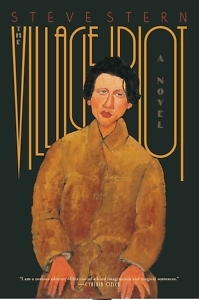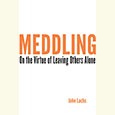Irrepressible Artist
Steve Stern paints a fictional portrait of Chaim Soutine
If asked to name some of the influential artists of the early 20th century, you might easily recall the big figures: Picasso, Dali, Matisse. A casual appreciator of modern art might remark on Modigliani or Chagall, but only a student of art history is likely to surface the name Chaim Soutine. His relative obscurity will vanish, however, for readers of Steve Stern’s novel The Village Idiot, a fictionalized account of the painter’s life that dives into the art, certainly, but also the relationships, politics, and context surrounding Soutine and the creation of his often overlooked masterworks.
The Village Idiot opens on a scene in Paris in 1917: an unconventional “regatta” proposed and carried out by none other than the painter and sculptor — and friend of Chaim Soutine — Amadeo Modigliani. This is no ordinary boat race, however; Modi (as his friends called him) has invited all his artist friends to craft sailing vessels out of scrounged materials, and the results are a marvel. The narrator explains, “I can imagine the scene: painters and sculptors waiting to compete in their jerry-built boats on an afternoon the poet Max Jacobs has declared the most glorious in the history of the world. The sunlight is unfiltered nectar; the soft-blowing April wind wears velvet gloves.”
Everyone is there:
Picasso’s contribution is The Neversink, a gaily painted Cubist contraption rocking dangerously in its berth, already on the verge of disproving its name. By contrast, the bark of Fernand Léger, on whose person you can still catch a whiff of the gas from Verdun, appears to be relatively seaworthy. So does Diego Rivera’s rubber dinghy (dubbed La Cacafuego), despite the heavy freight of its passenger. … Modigliani himself is seated imperially in an enamel bathtub, his red cravat floating behind him in the breeze, the tub harnessed to a troika of canvasback ducks.
 Stern will return to this scene throughout the book, and with good reason. It is ridiculous and delightful and poignant, capturing both the verve and the uncertainty of the place and its time. The war on the Western Front is ever-present but hasn’t yet brought its violent reality to France. The circumstances of these artists are diminished but not yet despairing. And Modigliani’s irrepressible spirit (fostered overmuch by absinthe and other spirits) refuses to give in to the general dreariness. But where was Soutine on this marvel of a day? Submerged in the Seine, breathing from an oxygen tank, providing the actual motor for Modigliani’s supposedly duck-drawn vessel.
Stern will return to this scene throughout the book, and with good reason. It is ridiculous and delightful and poignant, capturing both the verve and the uncertainty of the place and its time. The war on the Western Front is ever-present but hasn’t yet brought its violent reality to France. The circumstances of these artists are diminished but not yet despairing. And Modigliani’s irrepressible spirit (fostered overmuch by absinthe and other spirits) refuses to give in to the general dreariness. But where was Soutine on this marvel of a day? Submerged in the Seine, breathing from an oxygen tank, providing the actual motor for Modigliani’s supposedly duck-drawn vessel.
At this point, readers may well be asking, Really? Did this actually happen? In fact, it doesn’t matter whether it did. Stern builds, in a matter of a few pages, a fully realized world that readers will sink into, willingly and in full delight. Like the artist he features, Stern is generous and exuberant; where Soutine’s work is known for the thick layers and unrestrained swipes of paint, Stern’s work is an explosion of language. English, Yiddish, Italian, French — all are here and in abundance. Again, like the artists he portrays, Stern is a master of his form, crafting a narrative that overflows with wit, imagination, and humanity. Perhaps the most remarkable demonstration of Stern’s considerable skill, however, is the way he manages the chronology of this storyline.
That scene in the Seine, with Modi above in the bathtub and Soutine below in the diver’s suit, surfaces repeatedly because it is there, submerged, that Soutine sees, “the whole of his experience parading before him through a shaft of filmy sunlight penetrating the surface of the river. He needn’t recollect or anticipate anything, but simply trudge forward through a consolidation of time, suffering the events that came before and those that followed after” while the rope and the respirator “keep him tethered to the present.” It is this eternal present that Stern manipulates so beautifully.
Everything is always just happening to Soutine — he is always having his first crazy night with Modi, when they accidentally burn down a cafe; always meeting one woman or benefactor after another, each thinking or hoping they might be the one to save the dour and abrupt Soutine; always failing to bathe; always painting with a passion that is unmatched. In The Village Idiot, Soutine comes fully to life and is fully alive, even as Stern carries the narrative into the terrifying end, when the Jewish Soutine must wear a star and watch as his beloved is taken away, or as the pain he has lived with his whole life ultimately takes over.
There are many difficult truths in Soutine’s life, and Stern doesn’t shy from any of them. Instead, he offers to readers a biography, completely fiction yet seemingly true, a portrait as complete and inhabited as any Soutine could have painted himself.

Sara Beth West is a writer and reviewer, usually found at sarabethwest.com. She lives in Chattanooga with her family, dogs, and a cat who always, always, always thinks it is time for dinner.


